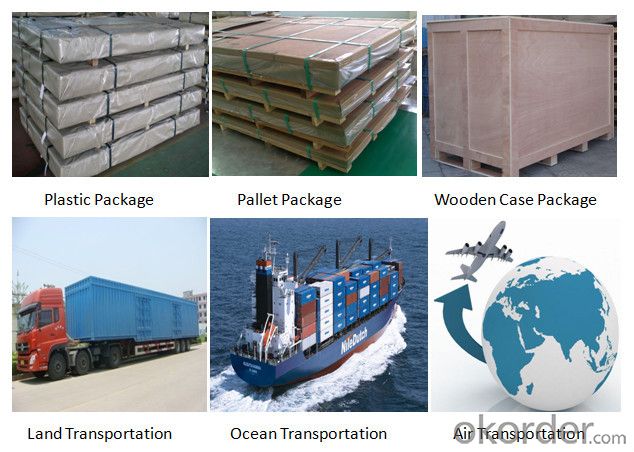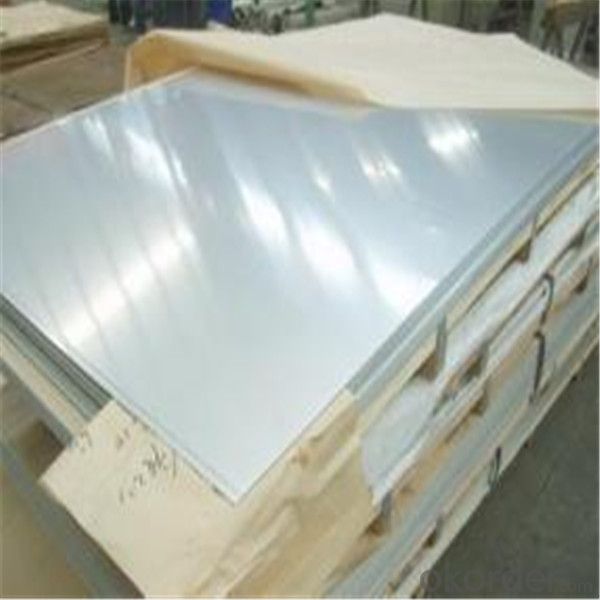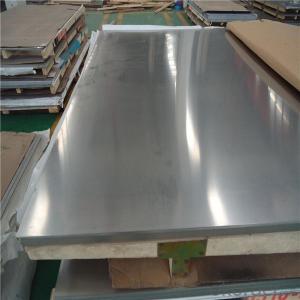SUS310 Stainless Steel Plate price per kg
- Loading Port:
- Shanghai
- Payment Terms:
- TT OR LC
- Min Order Qty:
- 3 m.t.
- Supply Capability:
- 1000 m.t./month
OKorder Service Pledge
OKorder Financial Service
You Might Also Like
Item specifice
SUS310 stainless steel plate price per kg
Product Description
1. Material: SUS310 / SUS310S
| C | Si | Mn | P | S | Cr | Ni |
| ≤0.080 | ≤1.50 | ≤2.00 | ≤0.045 | ≤0.030 | 24.00~26.00 | 19.00~22.00 |
2. Standard: ASTM, AISI,JIS, DIN,GB
3.Cold rolled 310 stainless steel plate
Thickness : 0.3mm-3.0mm
Width : 1000mm/1219mm/1500mm
Length : 2000mm/2438mm/4000mm/6000mm or cutting randomly
Model size : 0.3mm-3.0mm(thickness)*1000mm(width)*2000mm(Length)
0.3mm-3.0mm(thickness)*1219mm(width)*2438mm(Length)
0.3mm-3.0mm(thickness)*1500mm(width)*4000mm(Length)
Surface : 2B, BA, 8K, HL, 2D, NO.3 , NO.4 , Golden 8K, Black 8K etc.
4.Payment : Usually 30% T/T as deposit , and the balance against B/L copy .Or L/C at sight .
5. Package: Kraft paper+Hard board+metal/wooden pallet+metal strip or as customer requirement.
6. USE: construction.machinebuilding,container manufacturing,shipbuilding,bridges and so on.
Maintenance
Maintenance of stainless steel sheet
(1) Regular cleaning and maintenance
(2) Pay attention to prevent the occurrence of the phenomenon of surface scratches
(3) Use soap, weak detergent or warm water to remove surface dust, dirt
(4) In addition to the surface of the binder with alcohol or an organic solvent (ether, benzene)
(5) Use neutral detergent or ammonia solution in addition to surface oil
(6) With 10% nitric acid or abrasive detergent in addition to the surface of the embroider caused by the dirt.
Packaging & Shipping
1.Packaging:All products are packaged according to the Standard export packing.In order to prevent friction damage and water erosion and so on.
2.Shipping: Ocean transportation,land transportation or air transportation.



- Q:Are stainless steel sheets suitable for cryogenic applications?
- Yes, stainless steel sheets are suitable for cryogenic applications due to their excellent mechanical properties, low thermal conductivity, and resistance to temperature extremes. Stainless steel can maintain its strength and integrity even at extremely low temperatures, making it an ideal material for cryogenic storage tanks, pipelines, and equipment.
- Q:What is the thickness range of stainless steel sheets?
- The thickness of stainless steel sheets can differ based on the grade and purpose. Generally, they come in thicknesses ranging from 0.4mm to 6mm. Moreover, there are specific stainless steel sheets, like foil sheets, which are even thinner, measuring as fine as 0.02mm. Conversely, for robust applications, stainless steel sheets can be as thick as 50mm or beyond. Ultimately, the desired thickness of a stainless steel sheet hinges on the intended use, structural demands, and aesthetic preferences.
- Q:Can stainless steel sheets be used for heat recovery systems?
- Heat recovery systems can utilize stainless steel sheets. Stainless steel is known for its high thermal conductivity and corrosion resistance, making it an ideal material for heat transfer applications. In heat recovery systems, stainless steel sheets are commonly employed as heat exchanger plates or tubes because they efficiently transfer heat from one fluid to another. The corrosion resistance of stainless steel guarantees the durability and reliability of the heat recovery system, even in harsh environments and at elevated temperatures. Furthermore, stainless steel sheets can withstand thermal expansion and contraction, enabling their use in different heat recovery system designs. Overall, stainless steel sheets are a favored option in heat recovery systems due to their exceptional heat transfer properties, long-lasting nature, and resistance to corrosion.
- Q:What's the difference between 201 and 204 stainless steel plates? Thank you
- Different components: the main difference in nickel containing impurities, 201 such products performance 04 corrosion resistance, stamping performance far better than the 01, the 04 is generally used in complex environment, need strong resistance to corrosion for 01 place, environmental requirements are not very high, or the stainless steel demand is not high place
- Q:How do you attach stainless steel sheets to a wall?
- There are various methods available for attaching stainless steel sheets to a wall. Consider the following options: 1. Utilize adhesive: Apply a specialized construction adhesive for metal bonding onto the rear surface of the stainless steel sheet. Press the sheet firmly against the wall and maintain pressure until the adhesive cures. This technique suits smaller and lighter stainless steel sheets. 2. Implement screw fasteners: Drill holes through both the stainless steel sheet and the wall at regular intervals. Use stainless steel screws suitable for the sheet thickness and wall material. Insert the screws into the holes and tighten them until the sheet is securely affixed to the wall. This method is effective for larger and heavier stainless steel sheets. 3. Opt for magnetic mounting: If the stainless steel sheet possesses magnetic properties, you can employ magnets to attach it to a metal wall. Place strong magnets on the back of the sheet, aligning them with magnets on the wall. The magnets will hold the sheet in position, allowing for easy installation and removal. 4. Consider panel mounting systems: Some manufacturers offer specialized panel mounting systems specifically designed for stainless steel sheets. These systems typically consist of brackets or clips that attach to the back of the sheet and then hook onto a track or rail system mounted on the wall. This method ensures a secure and visually pleasing attachment solution. When attaching stainless steel sheets to a wall, it is crucial to ensure that the wall surface is clean, dry, and properly prepared. This will optimize adhesion and prevent potential issues. Additionally, always adhere to the manufacturer's instructions and guidelines for the specific method or product being employed.
- Q:Are stainless steel sheets suitable for petrochemical refineries?
- Yes, stainless steel sheets are suitable for petrochemical refineries. Stainless steel is a highly corrosion-resistant material that can withstand harsh environments and extreme temperatures, making it ideal for use in petrochemical refineries. It offers superior resistance to chemicals, acids, and caustic materials commonly found in refining processes. Additionally, stainless steel sheets have excellent mechanical properties and can withstand high pressure and stress, ensuring durability and reliability in refinery operations. The non-porous surface of stainless steel also prevents the accumulation of bacteria and other contaminants, making it hygienic and easy to clean. Overall, stainless steel sheets are a preferred choice in petrochemical refineries due to their exceptional corrosion resistance, mechanical strength, and ease of maintenance.
- Q:Can stainless steel sheets be used for conveyor belts?
- Yes, stainless steel sheets can be effectively used for conveyor belts. Stainless steel is known for its durability, strength, and resistance to corrosion, making it an ideal material for conveyor belts in various industries such as food processing, pharmaceuticals, and automotive. Its smooth surface also allows for easy cleaning and maintenance, ensuring hygiene and efficiency in conveyor operations.
- Q:What are the standard sizes of stainless steel sheets?
- The specific industry and application dictate the varying standard sizes of stainless steel sheets. Nevertheless, there exist some widely accessible commonly used standard sizes. In the architectural and construction sector, stainless steel sheets usually come in sizes ranging from 4 feet by 8 feet (1220mm x 2440mm) to 5 feet by 10 feet (1524mm x 3048mm). These dimensions find common use in cladding, roofing, and interior design applications. In the manufacturing and industrial domains, stainless steel sheets are available in diverse sizes, including 4 feet by 8 feet, 4 feet by 10 feet (1220mm x 3050mm), and even larger sizes like 5 feet by 12 feet (1524mm x 3658mm). These larger dimensions frequently serve fabrication, industrial machinery, and equipment manufacturing purposes. It is important to acknowledge that custom sizes can also be produced according to specific project requirements. These custom sizes may encompass narrower or wider widths, longer or shorter lengths, or even different thicknesses to cater to a particular application's needs. Ultimately, industry standards, market demand, and manufacturer capabilities determine the standard sizes of stainless steel sheets. It is advisable to consult suppliers or manufacturers to verify the availability of the desired size before making a purchase.
- Q:How do you cut stainless steel sheets?
- Cutting stainless steel sheets can be done using different methods, depending on the thickness of the sheet and the desired precision of the cut. Here are a few common techniques: 1. Manual cutting: For thinner stainless steel sheets (up to around 16 gauge), you can use a handheld shear or tin snips. These tools allow you to cut straight lines or curves by applying pressure and cutting through the sheet. However, this method may not be suitable for thicker sheets as it can be labor-intensive and produce rough edges. 2. Power shears: For thicker stainless steel sheets, power shears or electric nibblers are more effective. These tools use a sharp cutting blade or punch to make straight or curved cuts. They provide more precision and require less effort compared to manual cutting methods. 3. Circular saw: A circular saw with a carbide-tipped blade designed for cutting metal can also be used to cut stainless steel sheets. This method is suitable for thicker sheets and allows for straight cuts. However, it may produce more noise, sparks, and heat, so proper safety measures such as wearing protective goggles and gloves should be taken. 4. Plasma cutting: For industrial or heavy-duty applications, plasma cutting is commonly used. This method involves using a high-temperature plasma jet to melt through the stainless steel sheet, creating a precise and clean cut. Plasma cutting machines are expensive and require specialized training to operate. Regardless of the method, it is important to take safety precautions when cutting stainless steel sheets. Always wear protective gear, such as safety glasses, gloves, and a dust mask, to protect yourself from metal shards, sparks, and dust. Additionally, ensure that the sheet is securely clamped or supported to prevent it from moving during the cutting process.
- Q:How do you prevent pitting on stainless steel sheets?
- To prevent pitting on stainless steel sheets, it is important to avoid exposure to corrosive substances such as chloride-based cleaners or acids. Regular cleaning using mild, non-abrasive cleaners and soft cloths is recommended. Additionally, ensuring proper ventilation and avoiding prolonged exposure to high humidity or saltwater environments can help prevent pitting. Regular inspections and prompt repairs of any scratches or damages can also contribute to maintaining the integrity of stainless steel sheets and preventing pitting.
1. Manufacturer Overview |
|
|---|---|
| Location | |
| Year Established | |
| Annual Output Value | |
| Main Markets | |
| Company Certifications | |
2. Manufacturer Certificates |
|
|---|---|
| a) Certification Name | |
| Range | |
| Reference | |
| Validity Period | |
3. Manufacturer Capability |
|
|---|---|
| a)Trade Capacity | |
| Nearest Port | |
| Export Percentage | |
| No.of Employees in Trade Department | |
| Language Spoken: | |
| b)Factory Information | |
| Factory Size: | |
| No. of Production Lines | |
| Contract Manufacturing | |
| Product Price Range | |
Send your message to us
SUS310 Stainless Steel Plate price per kg
- Loading Port:
- Shanghai
- Payment Terms:
- TT OR LC
- Min Order Qty:
- 3 m.t.
- Supply Capability:
- 1000 m.t./month
OKorder Service Pledge
OKorder Financial Service
Similar products
New products
Hot products
Hot Searches
Related keywords





























